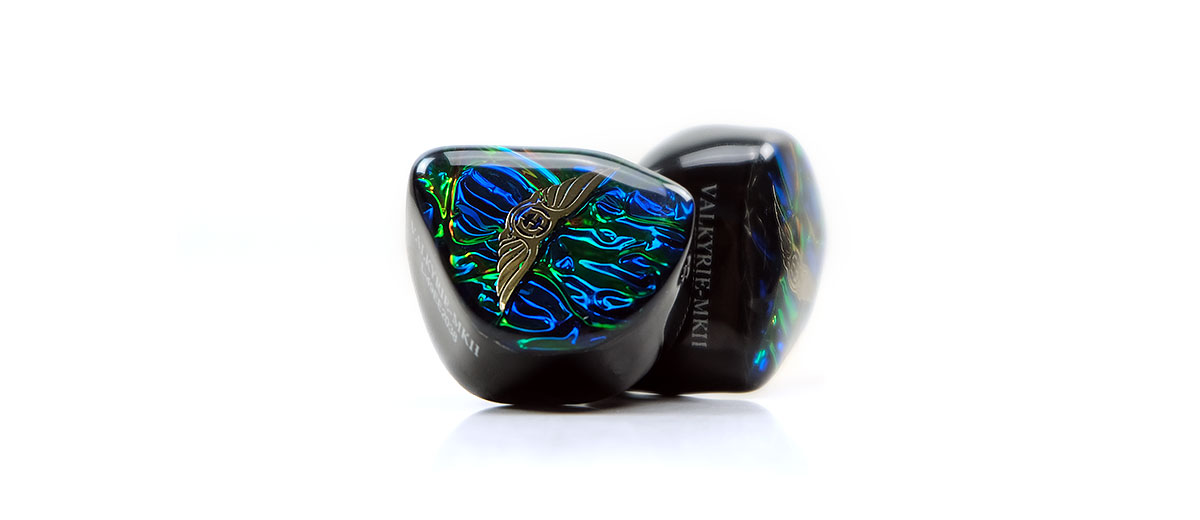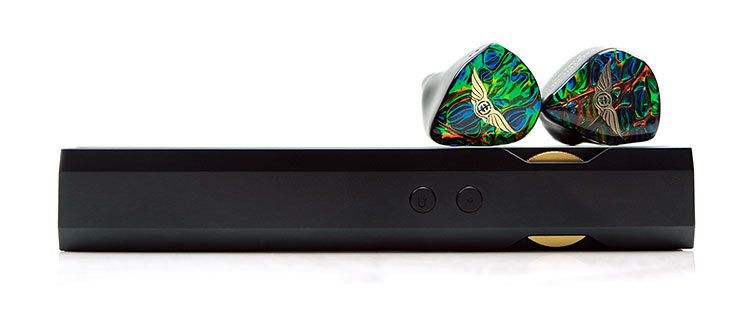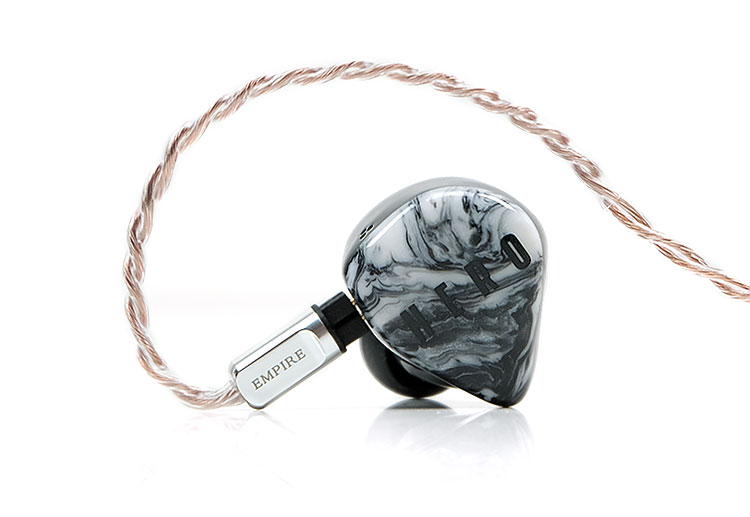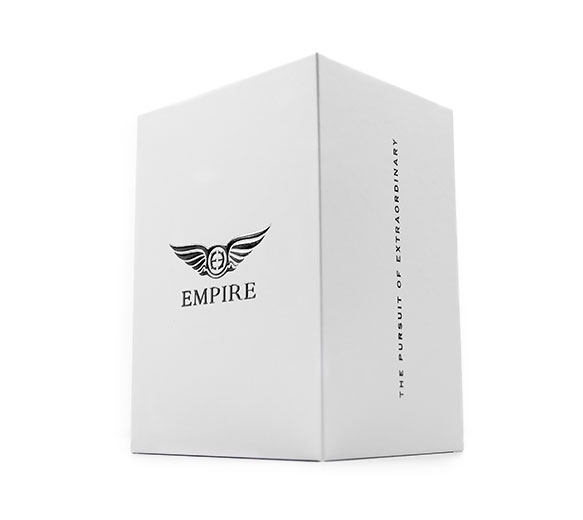Sound Impressions
Summary
Just a caveat before we get stuck in. The Valkyrie MKII I have here is a universal version with Final E single bore silicone tips and the older Valkyrie MKI is a custom design. There may be some inherent differences from differing formats but I do believe we can draw out some technical and tuning changes nevertheless.
The good news, the core presentation remains untouched. It is still a v-shaped explosive and fun-sounding monitor. This is one of the few IEMs I have heard that comes close to perfecting the basshead dream with a powerful sub-bass rumble, plenty of bass to mids separation, strong upper vocal emphasis, and a carefully balanced treble delivery.
It is a 100% nailed-on choice for fat bass synth, fast EDM, and modern R’n’B production values where the fun is ‘over 9000’. It is less of an audiophile reference tool. I called the MK1 my guilty pleasure and the Valkyrie MKII is no different in that regard.
So where are the changes? There are a mix of tweaks with the technical side being perhaps more dominant than huge FR changes which are a little more nuanced until you hit the highs.
Faster Bass
The first changeup is the introduction of the new Weapon IX+ driver which is much tighter and faster sounding than the original Weapon IX. With the MKI it sounded equally as weighted with the same extension for my money but the transient response is slower and lacking the same dynamic range and clarity compared to the new driver.
As a result, the new Weapon IX+ can pound equally as hard sub-100Hz but at the same time, the peak and fall on a note are quicker creating a bit more perceived space and less bloom towards the mid and upper bass.
Refined Mids
That is important because it allows the mids to grab their own defined space becoming a bit more vivid or clearer sounding than before. The mids are still defined by a fairly sizeable 1-4k elevation but this time around the peak is a bit stronger at 3-4k whereas the MKI leveled off a bit more from 2-4k.
If that sounds like a possible cue for splashy percussion and brighter vocals not quite because of the way the Valkyrie MKII treble has been changed. Again, this is somewhat of a technical change with the EIVEC tweak for the EST driver but it has resulted in an FR drop around the 5-7k range and stronger upper treble emphasis.
That takes a lot of sting out of any potential sibilance in those upper mids and actually offers a better harmonic balance than the original as a result. Upper mids voicing sounds as forward as ever but the tone is definitely more refined with a very balanced and almost sweet-sounding female vocal timbre.
Lower mids male vocal timbre, especially below 1k, is a little on the cooler side than before, however. I suspect the lack of bass bloom creeping upwards will do that but it also helps clear a bit of space for them to breathe a bit better and offer some improvement in clarity.
Silky Treble
The treble integration is a big step up for me with a drop in that 5-7k as mentioned before and a little more 8-10k emphasis. That creates additional headroom and a little less percussion aggression also so you get the extension but not quite as fatiguing as MKI might have been.
On the older MKI, there was definitely a stronger emphasis around 7k so that tended to creep into the mids a bit. I do think EE might have had to control the 1-4k elevation more than on the MKII to ensure the timbre didn’t sound sharp from that peak.
The end result is you simply get better ‘information’ from the Valkyrie MKII ‘s EST driver and a tone that blends in more naturally with that mids BA driver.
Staging
This naturally leads me to how much the soundstage has changed on the Valkyrie MKII compared to the MKI. In short, it is taller, more spacious on the low-end, and more open sounding in the mids.
This is probably the biggest takeaway from moving from the MKI to the MKII though it still has all the hallmarks of a classic V-shaped response curve for basic instrumental imaging. The low-end is very forward and deep up to 100Hz but it’s constantly dropping into the lower-mids so mid-bass, upper mids, and lower-mids progressively take a back seat in terms of imaging.
Female vocals are much further forward compared to lower-pitching male vocals but again there is better clarity from 500Hz to 1k because of the better control on the bloom so you can pick up on the detail a bit better now.
The enhanced headroom also injects some additional air around that 2-4k range. It is forward, possibly even more forward but there is more space around it creating a more holographic and open sound on the Valkyrie MKII.
Synergy
Efficiency
The Valkyrie MKII is rated at 3Ω and 100dB SPL which is marginally more sensitive on paper than the older MK1 at 3Ω and 96dB SPL. The lower dB is more to do with the power required by the EST driver than the dynamic driver by the way. Most EST monitors I have tested due tend to need more volume.
In real-world testing, the difference is marginal though given the MKI is a custom and the MKII is a universal there might be a bit more of a seal on the MKI helping to prevent leakage. Otherwise, I really did not find the need to adjust the volume between the old and the new versions.
In its own right, the Valkyrie MKII is not hugely sensitive compared to the likes of the Campfire Audio Solaris 2020 and just slightly less efficient compared to the Hero. EST drivers do require a bit more power to get busy compared to BA drivers but overall moderate to medium levels of volume from a good DAP in low-gain is more than enough.
My primary test DAP was the Luxury & Precision P6 which is capable of 700mW into a 32Ω load balanced. With a 4.4mm connection, the Valkyrie MKII was sitting around 35-37 steps in low-gain so no issues in terms of volume headroom.
Pairings
I have to admit the LP P6 and to a slightly lesser extent, the new iBasso DX300 were excellent matches for the Valkyrie MKII.
The P6 is a texture king with a bit of warmth thrown and a very analog tone overall. It delivered some incredible detail from the Weapon IX+ driver inside the Valkyrie MKII. It also fleshed out female vocals beautifully, probably one of the most impressive in terms of dynamic range performance also.
The DX300 gave me expanse and slightly more relaxed delivery. Perhaps not as much textural detail as the P6 on the dynamic driver but nevertheless brilliant extension on either end and a very smooth tone throughout the mids.
I would still recommend the Hifiman R2R2000 Red with the Valkyrie MKII, perhaps even more so now with the superior low-end impact of the Weapon IX+. You still get that sweet euphonic tone in the mids with this pairing which is especially nice with R’n’B vocalists.
Decidedly neutral or linear sources might need a bit of a push to maximize the low-end. Sources such as the FiiO M15 might be a little too clean and controlled in the mids to pair as well as the aforementioned DAPs.
Select Comparisons
Empire Ears Hero
$1349
Technical
The Hero was our most recent EE monitor review and perhaps one of the closest to the Valkyrie MKII in terms of general tuning.
In terms of configuration, there are some similarities with both opting for a single Weapon IX+ dynamic driver in a hybrid design with the synX 4-way crossover. However, the Hero differs beyond that opting for an all-BA setup beyond the lows with 3 proprietary balanced armature drivers with one for the mids, 1 for the mid-highs, and 1 for the highs.
The Valkyrie MKII is possibly a little simpler in terms of driver count with just a single BA for the mids but instead of BA for the highs it has that EST driver. That should mean treble timbre will be slightly different between these two monitors.
They do share a few other common technical features including Empire Ear’s A.R.C Anti-Resonance Compound damping resin on the internal components and the triple bass venting ports.
Efficiency ratings are a bit different. The Hero is rated at 17.6Ω impedance and 105dB SPL compared to the 3Ω and 100dB of the Valkyrie MKII. In our real-world tests neither require huge power, both avoid background noise quite nicely with the Valkyrie MKII the slightly more demanding of the two for current requirements.
Design
Both shared a similar design creed with an attractive faceplate, opaque onyx acrylic hollow-body shell, and strong contouring with similar fitting experiences. The aesthetical differences focus primarily on the front plate with the Hero using a noir-like finish with the Black Tide plate and the Valkyrie MKII offering a lot more pop and color with its Dragonheart design.
The comfort and isolation of both are the exact same with Final E stock tips so kudos to Empire Ears for developing a very consistent fit and finish on their range.
The stock cables are different with the Hero using the Alpha IV which is a 26AWG 4-wire multi-size UPOCC Litz copper strand geometry whereas the Valkyrie MKII uses the Alpha Hybrid IV 4-wire 26AWG UPOCC Litz copper/UPOCC silver hybrid cable.
Both have similar PVC translucent jackets and jack/connector options so the weight and handling are quite similar. The only difference is the sonic qualities of the different wires and the more attractive splitter finish of the Valkyrie MKII cable.
Performance
Both of these are solid v-shaped sound signatures but there are some differences and overall for my tastes, the new Valkyrie MKII tuning is the more natural and warmer sounding of the two.
On the low-end the L-shape to the lower-mids is steeper on the Valkyrie MKII with the Hero maybe 1-2dB less on the absolute low-end and a more gradual drop to 700-800Hz. Of the two, the Valkyrie MKII carries the more potent and physical sub-bass and slightly more body, if such as thing is possible since the Hero is very physical, to begin with.
Switching over to the treble and you can immediately pick up the difference in the FR tuning and the EST timbre. The new Valkyrie MKII has a slightly more relaxed lower-treble from 5-7k whereas the Hero stays consistently elevated from 4-7k.
You can easily pick up the EST timbre difference which is more refined and with the slight dip it has a smoother harmonic balance. That creeps into the mids also. Both have bumps for higher-pitching vocal presence with a strong lift from 1-2k.
However, the Valkyrie MKII stays elevated through to 4k whereas the Hero drops a bit over the same region giving some vocals a much better presence. I suspect the Hero dip is to keep the peppy treble BA from coloring the percussion and vocal with too much sharpness.
Not so with the Valkyrie MKII. It sounds more forward for female vocals, but also more solid, less ethereal, and with more natural timbre. That stronger bass also grounds the notes with a better fundamental for instruments that sound more solid with better impact.
Overall, both reach high and tall but the Valkyrie MKII is more refined and that shows with a smoother more pleasing midrange vocal performance.
64 Audio Nio
$1699
Technical
We reviewed the Nio last in 2020 and it does pack a lot of technical pedigree and features. This is a 9-driver hybrid universal monitor with a single 9mm dynamic driver, 6 BA for the mids, 1 BA for the high-mids, and one tia BA for the highs. All of those are woven together using an integrated 4-way passive crossover.
The Valkyrie MKII is much simpler with its 3 driver configuration but also uses a 4-way crossover, a slightly bigger 9.2mm dynamic driver, (Weapon IX+), and an EST driver for the highs. Both have very different sound signatures which you can read more about below.
Both companies have a lot of their own designed tech inside that is unique to each with the Nio using apex module filtering, tia tubeless for the highs, and LID for impedance balancing. The Valkyrie MKII uses its Weapon IX+ subwoofer technology, patented 4-way synX Crossover Network, as well as A.R.C. for the purposes of enhancing clarity and the bass response of the MKII.
The Nio is rated at 6Ω and 105dB SPL with the Valkyrie MKII at 3Ω and 100dB SPL. Both are relatively easy to drive, you won’t need more than low-gain from a decent DAP but out of the two, the Valkyrie MKII needs a little more volume or current. Neither have issues with high noise floors or background hiss from portable sources.
Design
Both the Nio and the Valkyrie MKII have some exquisitely designed faceplates with the Nio using a blue Abalone polished aesthetic and the MKII going for a flashy reflective Dragonhide color scheme. Both are distinct in their own ways.
Underneath, however, they are quite different with the Nio opting for 64 Audio classic 2-piece shell design crafted from a solid block of aluminum. This is a smooth finish with clean lines and a polished black main shell finish with chrome fenders.
The lighter black acrylic hollow body finish for the Valkyrie MKII does mean it is lighter, however. It also has more aggressive contouring making it a slightly more comfortable fit but the difference is not huge.
The isolation on both really depends on the Nio apex filter in use as it comes with 3 and each vent a little more or less than the other. I would place the Valkyrie MKII on the same level as the m15 apex module.
The Nio has a decent stock cable. This is a 48″ wire with an ultra-low resistance silver-plated copper (SPC) and a tight black jacket called the Premium cable. However, it is not quite the dynamic performer compared to the Alpha Hybrid IV and the finishing is a little more basic.
Performance
These two IEMs have a strong low-end dynamic driver impact, however, the Nio is not quite as sub-bass biased with less of a mid-bass dip so you get an equal mix of power and warmth. The effect is slightly softer for impact also with the reduced Nio treble response leaving less of a contrast in the low-end timbre.
The Valkyrie has much more sub-bass physicality, a cooler mid-bass timbre with a bit more contrast. Nio lower-mids instrumental notes have a bit more beef and presence on them by contrast. The stronger mid-bass dip does mean less instrumental richness in the MKII but it’s not as thin as the Hero for me and also does better than the original Valkyrie for a natural tone.
The Nio offers less treble energy and is not quite as forward and energetic sounding in the upper mids from 2-4k as well as upper treble from 8-10k. The Valkyrie MKII is more vibrant sounding from the upper mids through to the treble though slightly drier and cleaner.
Nio’s vocal and instrumental timbre is wetter, richer, and sibilant-free but also more rounded in tone due to the relaxed treble. The Valkyrie MKII upper vocals are further forward, a bit more vivid and clean sounding but still on the right side of natural.
Lower voicing on the Nio has a bit more warmth and body whereas the Valkyrie MKII equivalent is dipped a bit more and thinner sounding.
Overall, both the Nio and Valkyrie MKII hit hard but the Nio opts for a bit more softness and warmth up and through the mids and less treble energy for a more forgiving rich tone. The Valkyrie MKII is a more energetic explosive performance with better headroom but with a stronger level of timbral contrast.
Campfire Audio Solaris 2020
$1499
Technical
The Solaris 2020, like the Valkyrie MKII, is a refined version of an original. Technically, the Solaris 2020 is a gen 3 after the Solaris SE we covered earlier in 2020.
The Solaris 2020 is a different type of hybrid universal monitor with a mix of dynamic and BA as opposed to dynamic, BA, and EST inside the Valkyrie MKII. Inside, you get a slightly larger single 10mm A.D.L.C. dynamic driver, a single full-range BA for the mids much like the MKII, and a dual custom tubeless, (T.A.E.C), BA Driver for the highs instead of an EST driver.
Much like Empire Ears, Campfire Audio has a bunch of their own proprietary tech inside the Solaris 2020. This includes their tubeless highs via T.A.E.C versus EIVEC and their Polarity Tuned chamber for the dynamic driver as opposed to a front-firing port and rear-firing vent for the Valkyrie MKII Weapon IX+.
Campfire Audio has also refined the internal Solaris 2020 performance with a 3D printed interior and solid-body design as opposed to the MKII’s internal A.R.C coating and synX 4-way crossover.
The Solaris 2020 is rated a bit differently with a higher 15.5Ω rating compared to just 3Ω for the Valkyrie MKII. However, SP we cannot do a direct paper comparison as CA has started using a fixed dB rating and how much mVrms it takes to achieve this common standard dB.
However, as with the previous Solaris editions, this is a sensitive monitor, much more so than the Valkyrie MKII so you require a lot less volume, not a huge amount of power and it does tend to quickly pick up on high noise floors and background hiss.
Design
These are quite different design approaches and possibly one of the big reasons why there is a Solaris 2020 in the first place. The original and SE Editions were quite big for many users, whereas the Solaris 2020 is now 20% smaller making for a comfier overall.
The materials and form factors are quite different. The Valkyrie MKII is lighter with better contouring making for a comfier fit and slightly better isolation overall but not a huge gap between the two.
The Solaris 2020 is more robust and durable with an all-black PVD coated metal alloy body and a stainless-steel nozzle. It can likely take a few more knocks than the Valkyrie MKII.
The aesthetics are quite subdued on the Solaris 2020 with the all-black finish. I much preferred the gold and abalone finish of the previous models which had a bit more pop. Certainly, the Valkyrie MKII Dragonhide finish is visually more intriguing.
Cables and connectors are also quite different with CA continuing to use their excellent beryllium/copper MMCX connections. These last a long time with my original Lyra MK1 still going strong after several years. The Valkyrie MKII uses a more standard 2-pin 0.78mm termination with a flat socket on the main shell.
The stock cable on the Valkyrie MKII is a bit better looking for me being drawn from the original EA Eros II using that 26AWG hybrid silver and copper 4-wire mix and a PVC jacket with some attractive design touches on the splitter and connector barrels.
The Solaris 2020 keeps the theme dark with their Super Smoky Litz cable which does have one benefit being an 8-wire over a 4-wire and I do like the CA 8-wire performances, usually very punchy and open sounding.
Performance
The Valkyrie MKII is V-shaped with more power in its tuning compared to the controlled and integrated bass to lower-mids of the Solaris.
The Solaris 2020 also has a wetter treble compared to the livelier Valkyrie MKII EST driver. The Solaris 2020 is tuned for more genre flexibility whereas the Valkyrie MKII is an audio ‘low-rider’ king built to bounce with killer R’n’B and EDM.
The Solaris 2020 is better for lower-mids and male vocals compared to the Valkyrie MKII with more body, warmth, and much better presence.
The Valkyrie MKII does better than the Hero for warmth and body in the same region but it still has a heavy bass to mids separation with that lower-mids dip. You get plenty of bass fundamental and upper mids to treble contrast but not the same amount of body or forward instrumental imaging.
Midrange vocals around 1-2k general have a bit more presence to them on the Solaris 2020 with the bass not overwhelming them but they do sound slightly smoother. The Valkyrie MKII has more elevation from 2-4k do higher pitching vocals tend to be more vivid, airier, and forward in comparison.
The Valkyrie MKII picks up some sparkle from a stronger upper treble elevation which mixes in nicely with the upper-mids peak. You get a better sense of headroom and air whereas the Solaris 2020 fades it a little for me beyond 3-4k with only some minor bumping in the upper treble.
Overall, the Valkyrie MKII is deeper, taller, and better for clean vivid higher pitching vocals. The Solaris 2020 is more balanced, genre flexible with the better body in the lower-mids, and male vocal timbre.
Our Verdict
The Valkyrie MKII is still a basshead delight, an absolute riot of a tuning designed to really dig deep and rumble.
This time, however, it’s a little more refined and expansive sounding than the original. The new Weapon IX+ is a better dynamic driver no doubt. This is like the older version with an additional 5 cups of coffee down its throat for some serious speed.
That speed comes with space, not just on the low-end with less bloom but throughout with a more matured understanding of how to integrate that EST driver with the BA mids. Now it’s more expansive, more holographic, and just a bigger sound altogether.
Should you upgrade from old to new? Depends on your preferences but do not go looking for a new reference monitor here as with before. The core sound has not changed but the MKII is technically a better performer for me and just the perfect ‘fun’ monitor for my synthwave collection.
Empire Ears Valkyrie MKII Specifications
- 1 Next Generation W9+ Subwoofer – Sub-Bass/Bass
- 1 Proprietary Balanced Armature Driver – Mid
- 1 Premium Electrostatic Driver – High, Ultra High
- 4-Way synX Crossover Network
- EIVEC – Empire Intelligent Electrostatic Control Technology
- A.R.C. Anti Resonance Compound Technology
- Impedance: 3.0 Ohms @ 1kHz
- Frequency Response: 5 Hz – 100kHz
- Sensitivity: 100dB @ 1kHz, 1mW
- Handcrafted Alpha Hybrid-IV (AH4) 26AWG UPOCC Copper Litz, Silver Litz 4-Wire Cable







